Best things to do in Alter do Chão, Brazil: a local’s guide
Picture beautiful white-sand beaches in the heart of the Amazon. This paradisiacal setting brought fame to Alter do Chão, Brazil, earning it the nickname “Caribbean of the Amazon.” This charming village in Santarém, Pará, is the perfect destination for those looking to connect with nature and enjoy breathtaking landscapes, but it’s also much more than that. When talking about the best things to do in Alter do Chão, we can’t leave out the rich local culture, gastronomy, and other activities that go beyond the river beaches.
Besides taking boat rides along the Tapajós and Arapiuns rivers and hiking through the Amazon Rainforest, you can also visit traditional riverside communities, explore the igarapés (narrow rivers), kayak, dance to carimbó music, and try authentic açaí. It’s no wonder that every traveler I met there was reluctant to leave.
I spent 10 days in Alter last September, first participating in an art residency, then enjoying the village and exploring its main attractions. Now it’s time to share everything I discovered about the best things to do in Alter do Chão.
You might also like to read:
The best places to stay in Alter do Chão, Brazil
A complete guide to Manaus, Amazonas
TOP things to do in Porto Seguro, Bahia

How to Get to Alter do Chão
The village of Alter do Chão is part of the city of Santarém, and the most common way to start the trip is by flying there. Santarém airport is about 35 km from the village and has daily flights, mainly from Brasília, Belém, and Manaus, with connections from other Brazilian capitals.
Once in Santarém, it’s easy to get to Alter. If you want more comfort or if your flight arrives in the middle of the night, you can take a taxi or hire a driver recommended by your accommodation. The fare currently ranges between R$130 and R$150, depending on the number of passengers and the time of day.
If you want to save money, there’s a regular bus you can take. I didn’t take this route myself, as my flights were in the early hours, but friends did and said it was easy.
The bus doesn’t go directly to Santarém Airport, so you’ll first need to catch a bus from the airport to the Rio Tapajós Shopping mall in Santarém. From there, catch another bus to Alter do Chão, which departs every half hour. The bus only tends to fill up on weekends, when people from Santarém head to the beach. The trip takes less than an hour and drops you off in the center of Alter.
Another cool way to get to Alter do Chão is taking a boat trip to Santarém from Belém or Manaus. I was told it’s best to go from Manaus to Santarém or Santarém to Belém, as you’ll go with the current, making the trip shorter. The journey is done on traditional Amazonian boats and takes two to three days (it’s faster from Manaus to Santarém).
Prices vary depending on the route, type of boat, and accommodation. The most common (and cheapest) option is to pay between R$150 and R$250 to travel in a hammock, like most locals do, but some boats also offer private cabins. If you opt for the hammock, you’ll need to bring your own, but they’re easy to buy there for a low price.
I didn’t take these routes, but I traveled by boat on my first visit to the Amazon, when I went from Manaus to a nearby indigenous riverside community. It was a seven-hour boat ride on the way in and twelve hours back, and the journey along the river was one of the most interesting parts of the trip.
The journey to/from Santarém is longer, and I imagine it could get tiring, especially because, as I was told, people tend to play loud music most of the time. But it’s undoubtedly a rich experience for those wanting to get to know the local life.

Best Time to Visit Alter do Chão
Choosing the right time for your trip to Alter do Chão makes all the difference. There are two distinct seasons there: the rainy season and the dry season, and the scenery changes dramatically depending on the time of year.
If you want to enjoy Alter’s famous river beaches, go there during the Amazon summer, from August to September. If your focus is on boat trips through the forest and spotting more wildlife, it’s worth going during the Amazon winter, from January to July.
Either way, the climate is always hot and humid. What changes is the amount of rain, which is much higher in the winter than in the summer. Generally, the driest period is from August to October.
Amazon Summer (August to December)
During the Amazon summer, from August to December, the river water levels drop, and the beaches emerge. The weather is usually stable, with sunny days and beautiful sunsets.
This is the high season there, and on holidays or during school vacations (December and January), the village gets quite busy, and hotel prices tend to rise. Fortunately, there are many beautiful spots to enjoy, so you can still have a good time without feeling crowded.
Another particularly busy time in Alter, still during the dry season, is during the Sairé festival. This traditional festival combines Catholic and indigenous influences and takes place on different dates each year but always in September.

Amazon Winter (January to July)
In June, the rain starts to decrease, and the beaches gradually appear. To ensure you experience the dry season and the beach landscapes, it’s best to go from August onwards. Before then, there are few sandy areas, and it rains a lot.
On the other hand, this period allows for beautiful trips through the igarapés and channels that form within the forest. I wasn’t there during this time, but it’s undoubtedly a beautiful season, and you’re more likely to spot local wildlife. It’s also quieter, with fewer tourists, except for July, when it’s also school holidays in Brazil.

Main Attractions in Alter do Chão
So, what is there to do in Alter do Chão? I warn you this article will be long, because there is no shortage of attractions! I’ll start with those located within the village itself.
Ilha do Amor (Island of Love)
It’s almost impossible not to at least take a peek at Ilha do Amor, the main postcard image of Alter do Chão. Located right in front of the village’s Central Square, this island of white sands sits in the middle of the Tapajós River, dotted with tents that function as bars and restaurants. It’s easily accessible by a short boat ride or even on foot (during the dry season, when the river level drops).
The beach bars place tables and chairs near the river, and some charge a minimum consumption fee for the “best” tables, where you can dip your feet in the water. However, when I went alone and arrived early, they didn’t charge me. The bar staff also place hammocks in the river, where you can relax. Additionally, some people rent paddleboats and offer banana boat rides.
During the Amazonian summer, especially on weekends, the island can get quite crowded. But you can still enjoy it calmly if you go early in the morning or walk along the Tapajós shore to find a quieter spot.
That’s what I did when the tables started getting too crowded, and people arrived with their speakers: I walked until I found the shade of a tree and spent the day there in peace. If you plan to do this, remember to bring water and snacks. Some vendors pass by the quieter areas selling drinks and snacks, but it’s not guaranteed.
Ilha do Amor is also a great place to watch the sunset, which is always a highlight on lists of things to do in Alter do Chão.

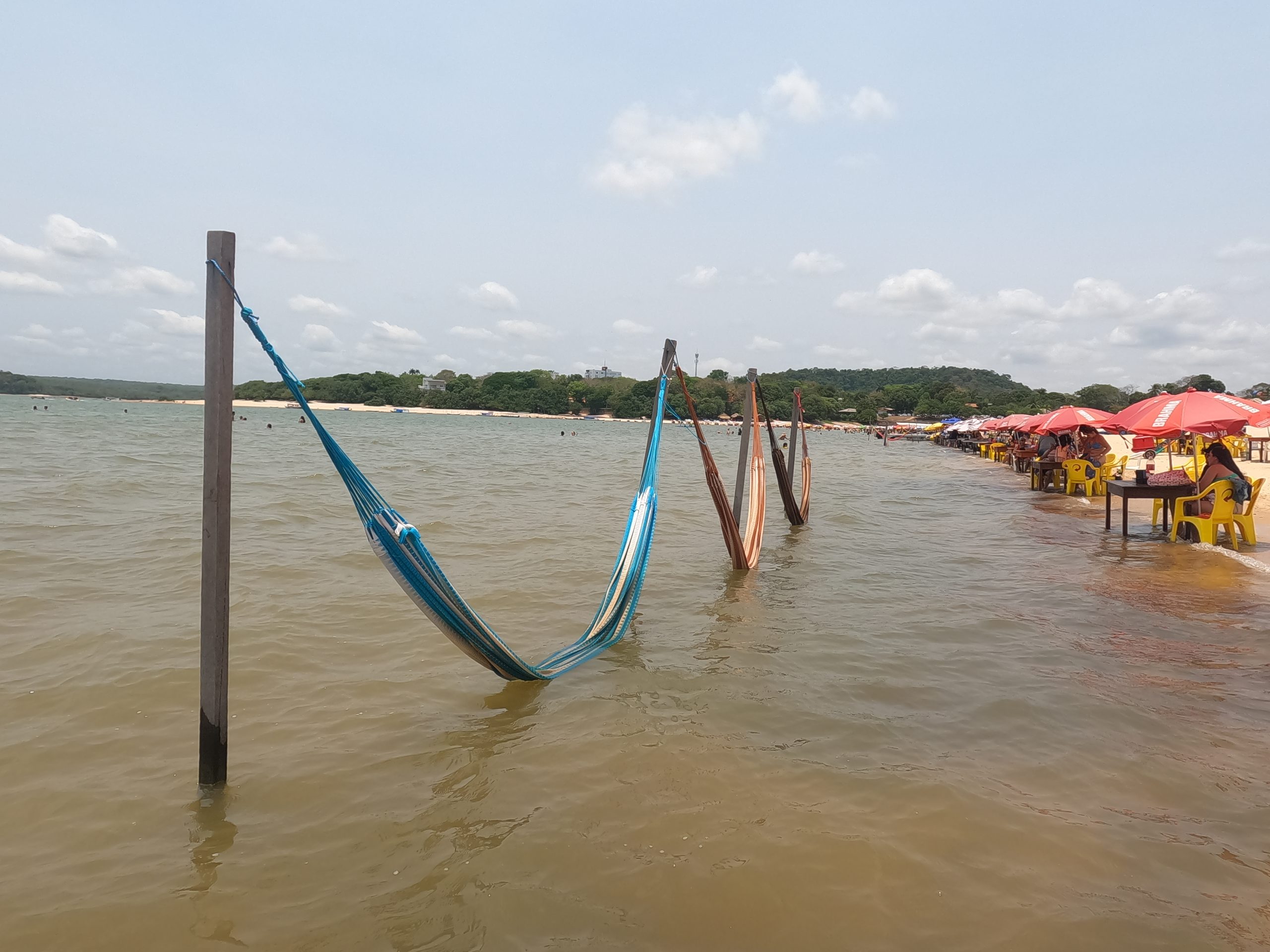
Morro da Piraoca (Piraoca Hill)
Feeling energetic? Then take advantage of being on Ilha do Amor and hike Morro da Piraoca, which stands out in the landscape at 110 meters high. The trail is fairly easy, taking about 40 minutes to complete.
Most of it is flat, but there’s a steep section with loose rocks near the end. It’s best to wear sneakers or sturdy sandals unless you’re used to hiking in flip-flops.
The biggest challenge is the near-constant heat in Alter, so I recommend going early in the morning or late in the afternoon — many people go at this time to catch the sunset.
Once at the top, you’ll be rewarded with a panoramic view of the surroundings. You can admire the Tapajós River, Ilha do Amor, and vast forest areas. I love seeing places from above because it gives them a different dimension, so I thought it was worth it.
The start of the trail has a small sign; you can ask the beach bar staff for directions. You don’t need a guide. Remember to bring water. There’s no structure up top other than a wooden bench, and there’s little shade.

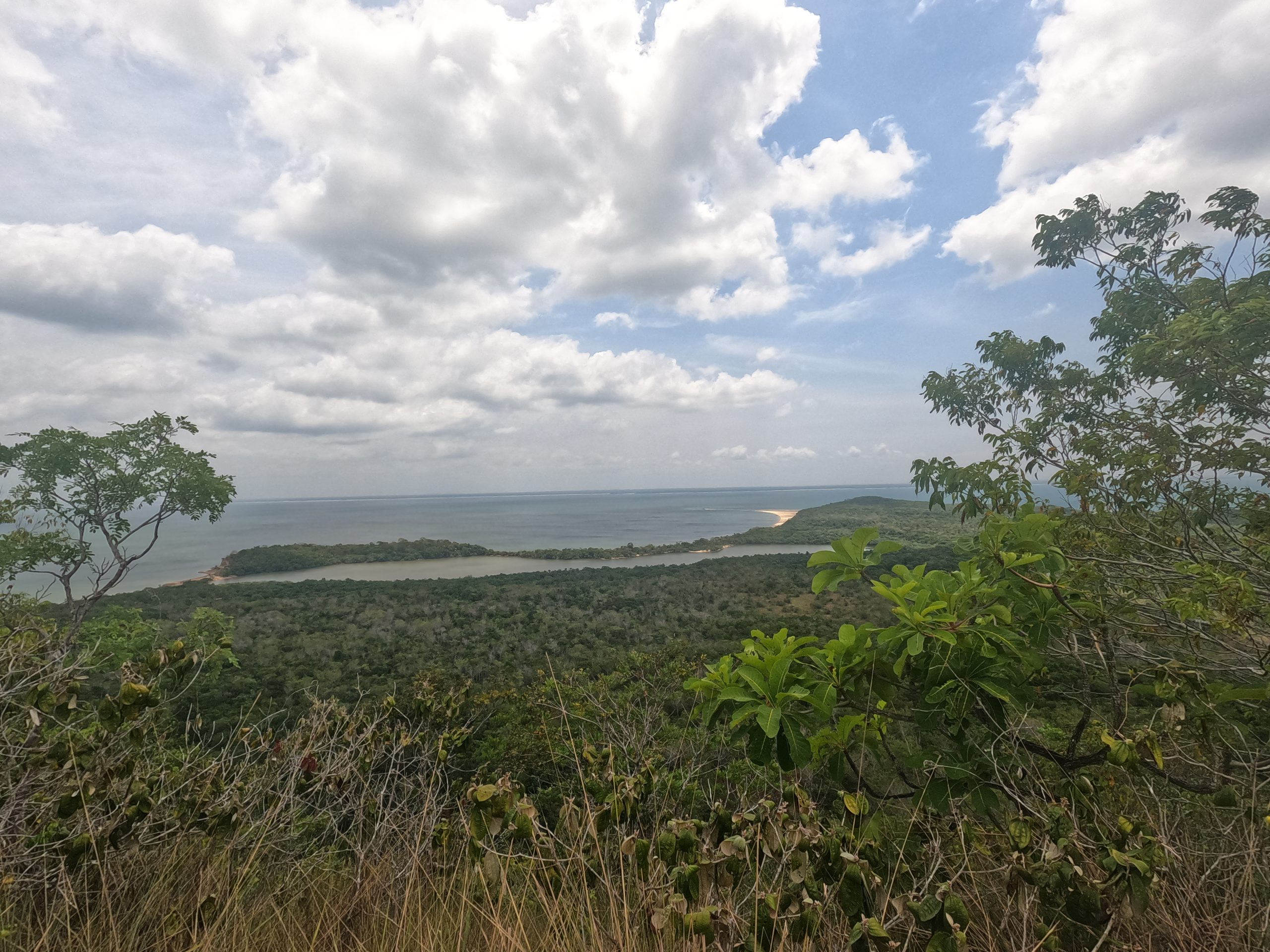

Lago Verde (Green Lake) and Floresta Encantada (Enchanted Forest)
Other nearby attractions include Lago Verde and Floresta Encantada. Also known as Lago dos Muiraquitãs, Lago Verde is surrounded by dense vegetation, creating a serene setting. In this area, you’ll also find igarapés (Amazonian creeks) like Camarão and Macaco.
I did a tour of Lago Verde with the agency Tuca Tours (@tuca_tours on Instagram), run by a friendly couple. Tuca is from Recife, and his partner, Carol, is from Brasília. Both have lived in Alter do Chão for decades and are connected to the local community and environmental preservation efforts.
The tour was organized during an artist residency I attended in Alter. We didn’t do the full itinerary because we had a workshop afterward, but it was still a delightful experience. We first went to Ilha do Guajará, a 15-minute boat ride from the village, where we enjoyed the beach under the shade of the trees.

For lunch, they prepared grilled fish with fish flour and plantain farofa, served with graviola juice in locally made bowls supported by artisanal baskets, the way locals eat. The food was delicious, and enjoying local flavors in the midst of nature was really cool.
Afterward, we took a leisurely 25-minute walk to Igarapé do Camarão, which is unlike any other place I’d seen in the Amazon. It felt otherworldly; even though it wasn’t a deep creek, the refreshing cool water was delightful.


The tour would continue with a stop at Igarapé do Macaco, on the other side of the lake, and then sunset viewing at Ponta da Valéria. If you want a similar experience, contact Tuca Tours at (93) 99111-7047.
Floresta Encantada, accessible from Lago Verde during the rainy season, is perfect for canoeing through the flooded forests. I didn’t take this tour in Alter because I visited during the dry season, but I have done it elsewhere in the Amazon, and it’s one of my favorite experiences.
You navigate among the submerged trees, watching sunlight filter through the treetops, creating reflections on the water. It’s a great chance to experience local biodiversity, with opportunities to spot fish, birds, sloths, and river dolphins.
Sunset
One of the best things to do in Alter do Chão is watching the sunset, and there are many spots to enjoy this spectacle. Every day, I was amazed by the many colors of the sky over the river.
Most full-day boat tours include a stop at a beach to watch the sunset, such as Ponta do Cururu (a popular sunset spot) or Ponta do Muretá. Watching it from the boat is also incredible.
If you’re in the village, watch the sunset at Ilha dos Amores or Praia do CAT (the beach where the Tourist Assistance Center is located), where boat tours depart and return.

Crafts
Craftsmanship is an essential part of the local culture, reflecting the rich indigenous heritage and the locals’ connection to the Amazon. In the village, you’ll find some stores selling beach items like flip-flops and hats alongside local crafts, as well as shops solely focused on artisanal items.
The most complete craft shop I saw was Araribá, near the Central Square, offering hundreds of items made by various traditional communities.
Popular crafts in Alter include necklaces, bracelets, and earrings made from seeds, feathers, and other natural materials or colorful beads. The famous muiraquitãs, frog-shaped amulets of indigenous origin, are also sought after for their symbolism of luck and protection.
My favorite craft in Alter was made from tucumã palm straw, an Amazonian native palm. I found small and large baskets, bags, lamps, placemats, potholders, and coasters in the village shops. But it’s even better to buy directly from the source during the Coroca community tour, which I’ll discuss below.
By purchasing crafts in Alter, you’re not only taking home a memento but also supporting the local economy and encouraging the preservation of cultural traditions.

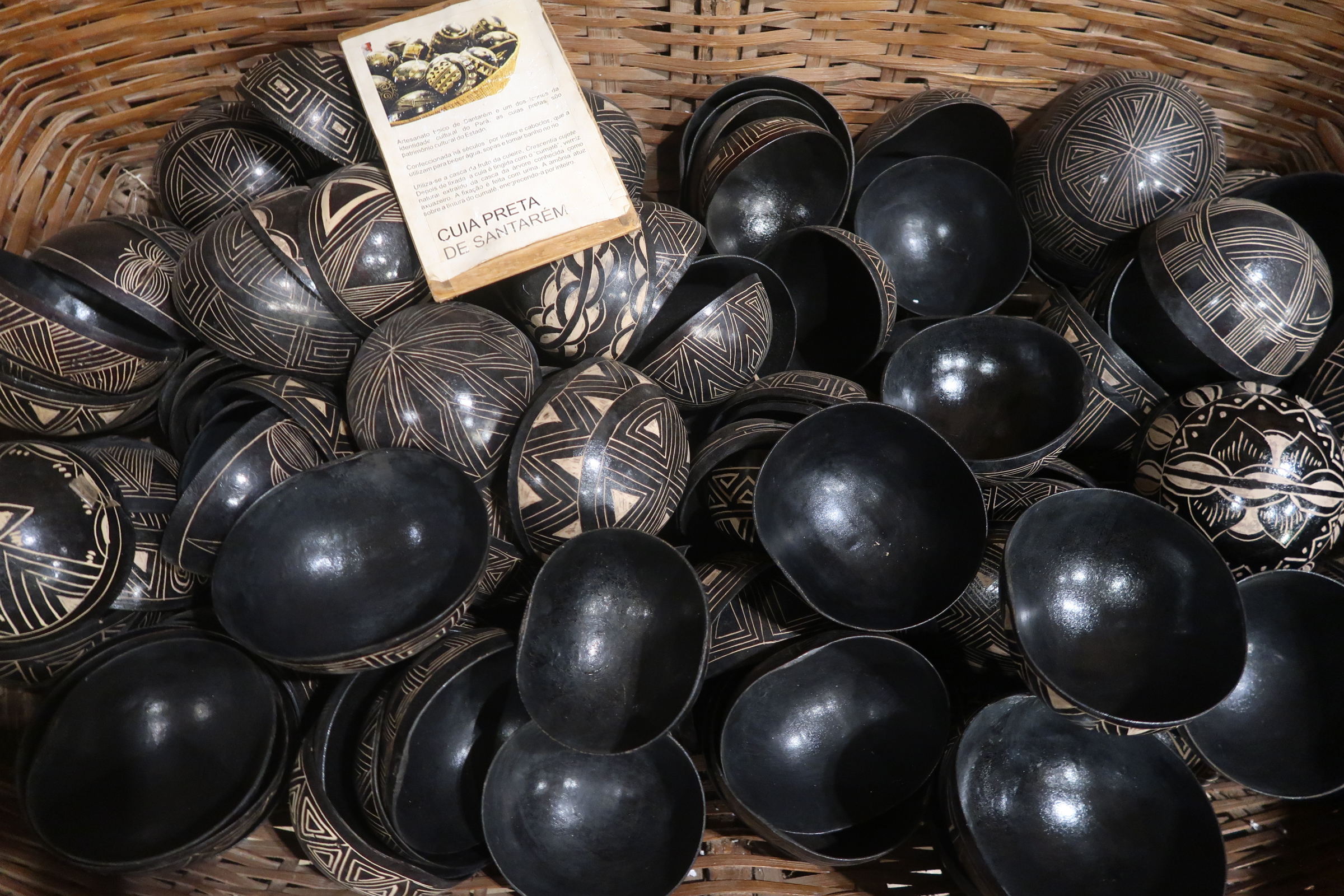
Carimbó
Carimbó is a significant cultural expression from the state of Pará. With indigenous and African roots, this traditional dance involves drums, maracas, and other instruments, creating an upbeat rhythm.
In Alter do Chão, it is present throughout the village, especially during the Sairé festival. To find out where and when there will be carimbó performances during your visit, ask the locals. When I was in Alter, there were almost daily performances and dance circles.
If possible, join in; locals are usually willing to teach the steps. And if you’re a woman and can borrow one of the large floral skirts worn by the dancers, even better. I’m not a great dancer, but I feel like the skirt gives me superpowers!
Speaking of Carimbó, one of the most interesting things to do in Alter do Chão is joining the Pirarimbó, a mix of Piracaia, storytelling, and carimbó. Piracaia is how the early residents of Alter prepared freshly caught fish right on the beach, roasting it on the sand with sticks. This practice is still common.
The event’s host is carimbó master Hermes Caldeira, born and raised in the village. He comes from a family with a tradition of music and preserving local culture.
This evening tour departs from Alter do Chão’s waterfront on a motorboat. After about 10 minutes, you reach a beach on Lago Verde or Tapajós, where the carimbó session with the master begins. Later, tourists enjoy a delicious dinner prepared on the beach caboclo-style and listen to local tales.
I couldn’t participate, but I met people who did and loved it, saying it was the best meal they had in Alter. For more information, visit the Piracarimbó website.

Where to Eat in Alter do Chão
Now let’s get to one of the tastiest topics when talking about things to do in Alter do Chão: food! I didn’t have a single bad meal there. I didn’t go to the most famous and sophisticated restaurants, but ate really well, nonetheless.
If you don’t know what to order, note that all fish dishes are delicious. My favorites are pirarucu and tambaqui. Duck in tucupi sauce is also amazing, with a unique flavor. Also, try the duck coxinha with jambu and tacacá.
Another interesting choice is the pure açaí they consume there, which is very different from what we have in other regions of Brazil and abroad. Its taste is super strong, but it’s worth trying, preferably alongside fish.
Many of the meals I had in Alter were during full-day boat tours. I ate really well both in the Jamaraquá community, where I went hiking in the National Forest, and in the Coroca community, on the Arapiuns River. There, you choose the fish you want, and the sides are the same: beans, vinaigrette, and farofa. Everything was very tasty and VERY generously served.
The most famous and popular restaurant around Alter is Casa do Saulo, located on Carapanari Beach. You can spend the day there, but it’s also possible to visit during some tours, like the Canal do Jari one.
Another common option is to have lunch at the beach kiosks on Ilha do Amor or other nearby beaches, like Pindobal Beach and Ponta de Pedras Beach. I had lunch at Pindobal during a tour of the Belterra beaches, and I really enjoyed the food.
It’s important to know that on many of the other beaches near Alter there’s no infrastructure, so always ask the tour agency or boat driver if there will be a meal stop. If you’re planning to stay on the more deserted beaches (which I loved!), bring snacks and water.
Want to know where to eat in Alter’s main village? Around the Central Square, between the Nossa Senhora da Saúde Church and the riverside boardwalk, you’ll find snack stands, a small market, and most of the restaurants and bars in Alter, but it’s also worth exploring other nearby streets.


One day, I ate at the restaurant right in front of the “Alter do Chão” sign by the riverside (I can’t remember the name and couldn’t find it on Google Maps), and another day I went to Saborari, as they were the only places open in that area when I arrived in town (around 4 pm). I didn’t find them spectacular, but I wasn’t disappointed either.
Among the places recommended to me that I didn’t get to try are Cantinho do Caranguejo, Ty Comedoria, and Arco-Íris da Amazônia.
A bit hidden, but close to Praça Central (Central Square), is the burger place X-Bom, which I visited twice. They offer burgers with various flavors and many different toppings, but I ordered the same thing both times: fish burger with cream cheese, fried banana, cheese, and potato sticks. So good! Right next door, there’s an excellent juice shop with great prices (a 500ml cup of acerola juice was R$12).
For dessert, I recommend the ice cream from Boto Gelateria, close to the church. It’s pricey but very tasty – try the cumaru cone, which is called “vanilla of the Amazon.” I had the açaí and tapioca flavors and loved them. I wanted to go back to try other ice cream flavors and cones, but they were closed. I ended up having açaí at Veneta, which is right next to the ice cream place, and it was great (bonus points for the air-conditioned seating).


Main tours from Alter do Chão
Thought that’s all there is to do in Alter do Chão? Not at all! We’re just getting started. There are several fantastic tours to enjoy around the village. You can customize an itinerary by hiring a boatman for your group, but there are a few classic tours that are absolutely worth doing.
I did two days of tours in partnership with Lugarejos, an agency that is part of the MUDA! Brazilian Collective for Responsible Tourism like me. They’ve recently started operating in Alter and, for now, only work with closed groups on pre-set dates. I joined a group that was already “in progress” and spent two days touring with them.
I always try to choose companies with a good reputation, dedicated to sustainable and ethical tourism that respects the environment and local communities. Besides knowing they have this awareness, I found Lugarejos’ service excellent, and the local providers were very professional. Highly recommended!
If you prefer to decide on the spot, that’s also an option. You might not be able to follow the entire itinerary as planned, but you can schedule tours with local agencies, guides, and boatmen recommended by your accommodation or with the Alter do Chão River Tourism Association (Athufa).
Other companies I encountered were Tuca Tours (@tuca_tours on Instagram), which I also recommend, and Mãe Natureza. With the latter, communication was a bit confusing, and they delayed our departure time, but the tour was nice.
Flona do Tapajós
On my first day of excursions in Alter do Chão, I went to explore a small part of the Tapajós National Forest (Flona), a reserve covering more than 527,000 hectares. There are various communities that can be visited in the area, each offering a unique experience of connection with nature and local ways of life.
One of them is the Maguary community, where you can hike to the largest samaúma tree in the region, a massive and ancient Amazonian tree. It is affectionately known as “grandma” or “big grandma” (vovó/vovozona) and is considered sacred by the indigenous people. However, this trail is longer and does not have one of the charms of the trail from the Jamaraquá community, which I visited: a beautiful igarapé (Amazonian river creek).

I took the Flona Jamaraquá tour with Lugarejos. Departing in the morning, we took a boat that took about an hour to reach the community. You can also drive there, which takes about 1.5 to 2 hours, but the guide told us there can be muddy spots.
The Jamaraquá community has 172 inhabitants and has been receiving tourists since 2001, which is their main source of income. Currently, there are 40 guides working there, including several women, and new guides are in training—all locals.
The guides’ service is charged separately, but it was included in the Lugarejos package. They currently charge R$ 200 for a day for up to 5 people, and if the group is larger, it’s R$ 40 per person. Each guide gives 20% of their earnings to the residents’ association, which uses the funds for community improvements, such as building the local school (which appears in the second photo below).


We were welcomed by our guide, Paulinho, who was very friendly and shared a lot of information about the forest and curiosities about riverside life. He guided us along the trail, which is about 11 km long and begins in a secondary forest that was once used for planting cassava. As we entered the primary forest, we were greeted by an impressive diversity of century-old trees that tell the history of the region.

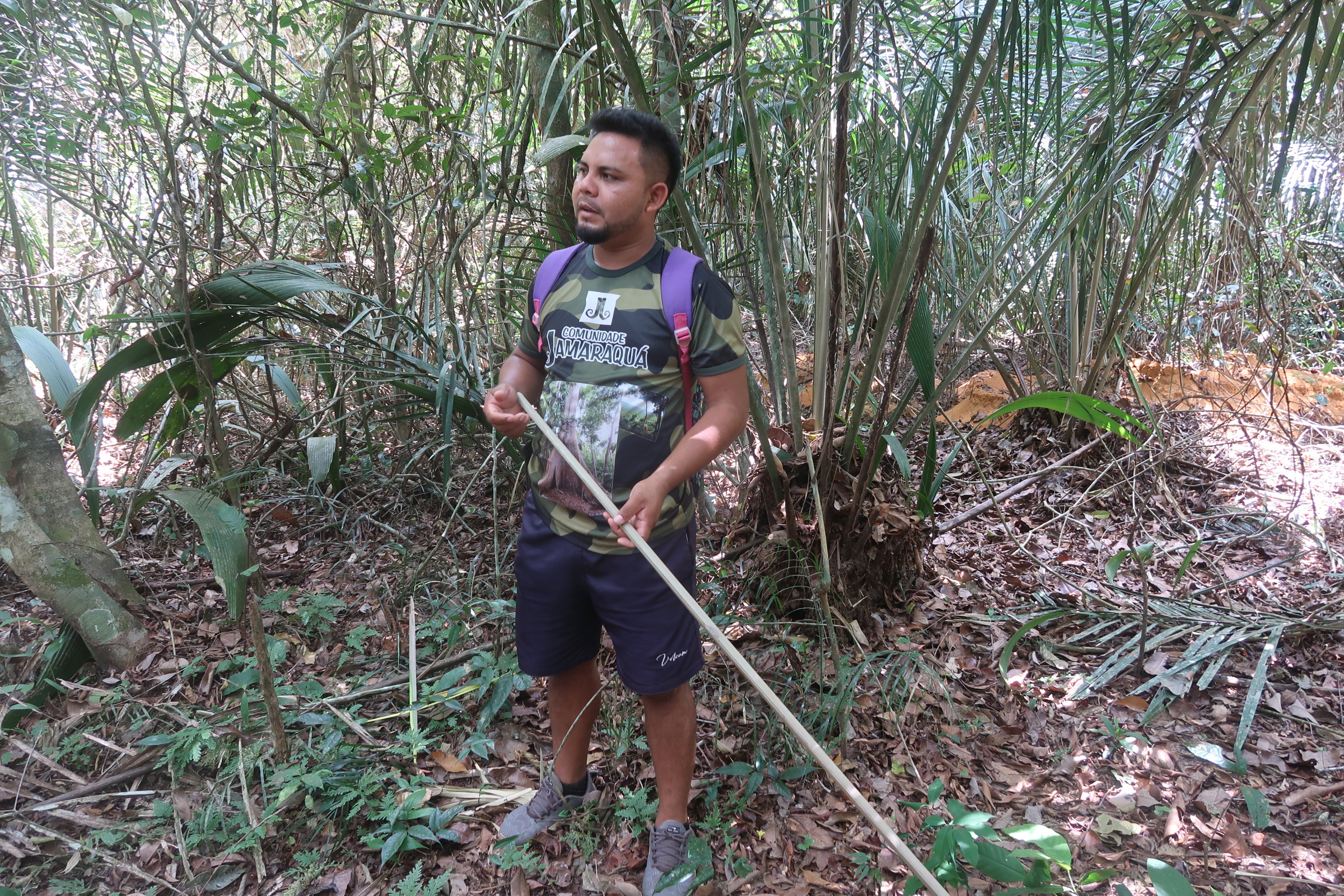
Along the way, Paulinho introduced us to several trees with medicinal properties, such as Sucuba, which is common in backyards there and provides a “milk” used as medicine. He also showed us a rubber tree and demonstrated how to extract latex.

We continued on the trail to a higher point, where we found a wooden deck with a stunning view of the forest and the river in the background; it was breathtaking!
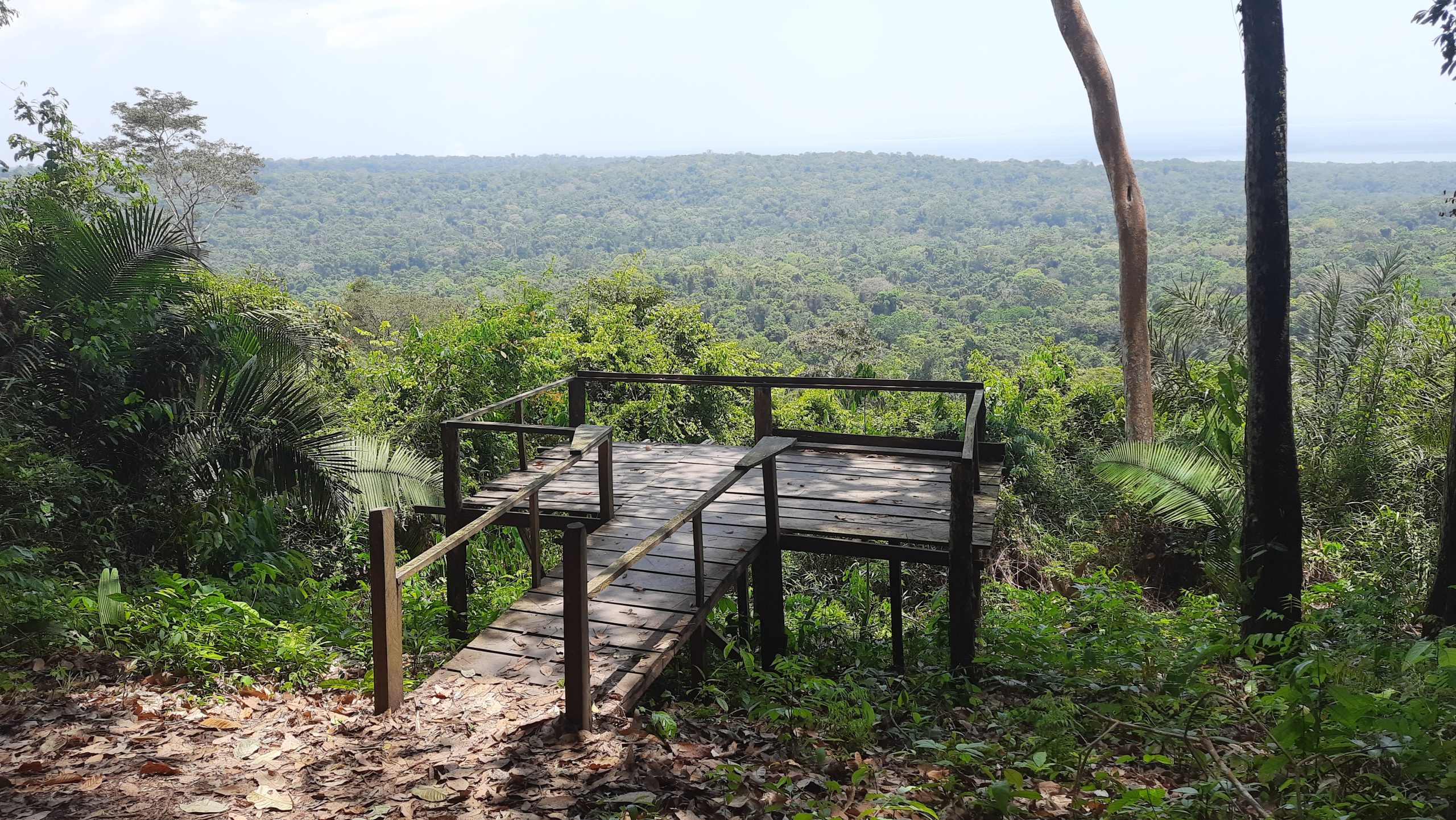
We also saw a beautiful samaúma—not as large as the big grandma, but still magnificent. I had seen some samaúmas before, but I always feel moved by their grandeur. Besides taking photos, it’s worth stopping to appreciate it in silence, without haste. There’s something magical about it.

After that, we headed to the igarapé, which was one of the most beautiful I’ve ever seen. We spent some time swimming in its cold, refreshing waters—quite different from the rivers in Alter, which are almost warm.



The return trail took another hour without stopping. We had already chosen the fish we wanted to eat before starting the hike, so the food was served promptly, and it was delicious. We paid R$ 50 per person and it was very much worth it.


Since groups only return to the community for lunch around 3:30 PM, it’s advisable to go well-fed or bring a snack. I also recommend bringing at least a liter of water, as the heat is intense, especially in the primary forest section. I brought only 500 ml and got thirsty. Also, it’s good to wear sneakers. If you’re allergic, bring repellent; I didn’t get bitten, but you never know.
On our way out, we stopped to watch the sunset at Pindobal beach. The boatmen can also make stops at other beaches, such as Ponta do Cururu or Ponta do Muretá.
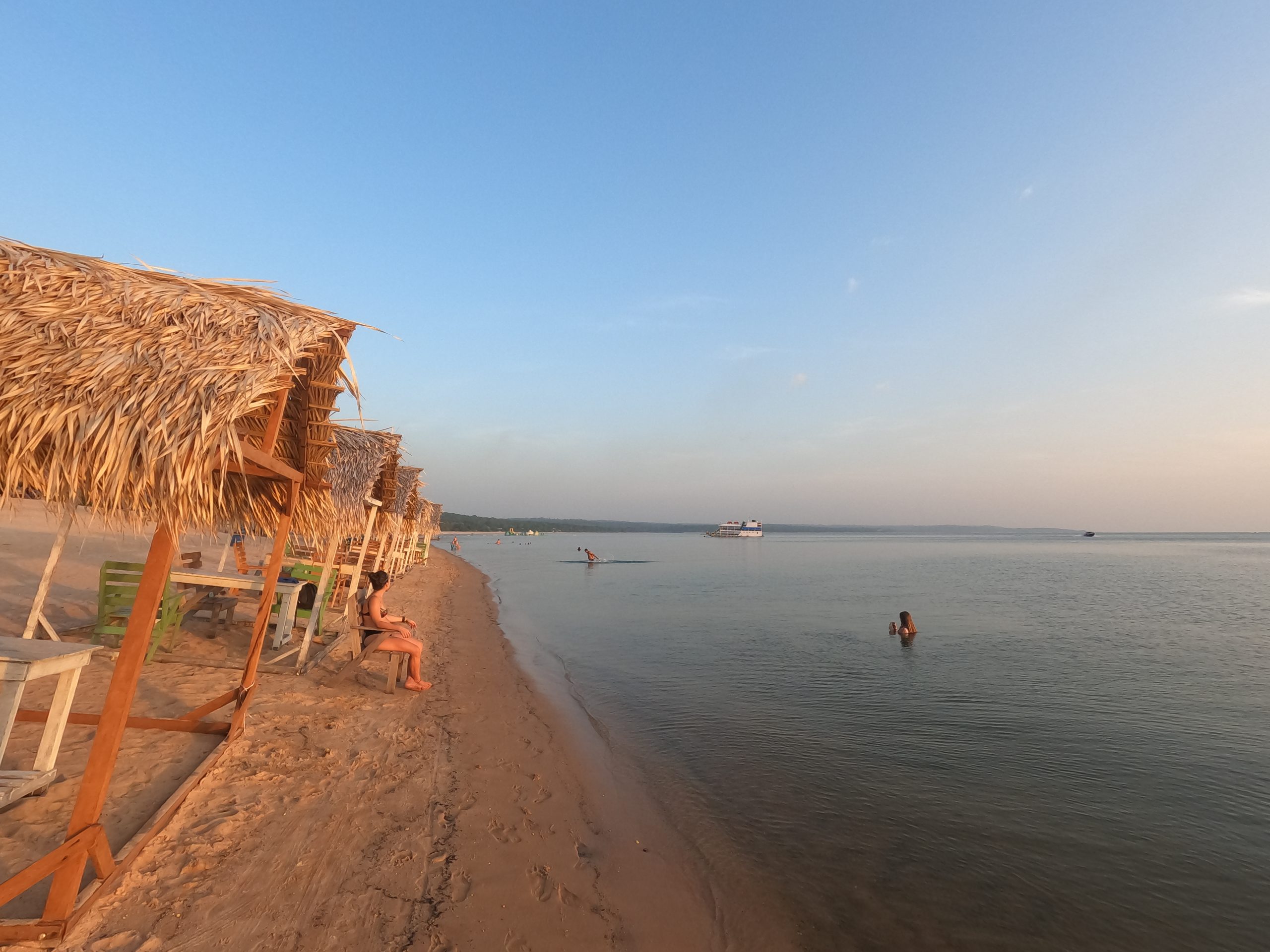
In addition to the daytime visit to Flona, it’s also possible to do an overnight trip there. Groups can camp in the middle of the forest (we saw the structure by the viewpoint, and I imagine the sunrise there is incredible) or by the Tapajós River.
Rio Arapiuns and Coroca Community
On my second day of excursions in Alter do Chão, I took another classic and very cool route: visiting the beaches of the Arapiuns River and the Coroca community, which has an amazing Community-Based Tourism initiative. In addition to hosting tourists, the community also has a meliponary, a craft store, and a turtle conservation project.
I also did this tour in partnership with Lugarejos, with the same boatman from the previous day, and it was great.
The tour usually starts by visiting some of the beautiful beaches of the Arapiuns. Among the most well-known are Ponta Grande, Ponta do Toronó, and Ponta do Icuxi.
Leaving from the port at Praia do CAT, we took the boat for nearly two hours on a bumpy ride; the river is quite choppy, so be prepared for some splashes along the way. The good thing is that it isn’t salt water, so just protect anything that shouldn’t get wet and enjoy. I found it fun! It felt like being in a water park.
Unfortunately, we didn’t stop at Praia do Icuxi as planned because there had been many stingray attacks in the area (you need to be careful of them in Alter by shuffling your feet in the sand when entering the river). So, we headed to Ponta do Toronó, which has a long stretch of white sand. I loved it! We spent about an hour there before moving on to Coroca.


The Coroca community currently has 70 permanent residents, comprising 23 families. Once you arrive, you can enjoy the place on your own, but I recommend taking the short, guided tour, which is charged separately (though it was included in the Lugarejos package).
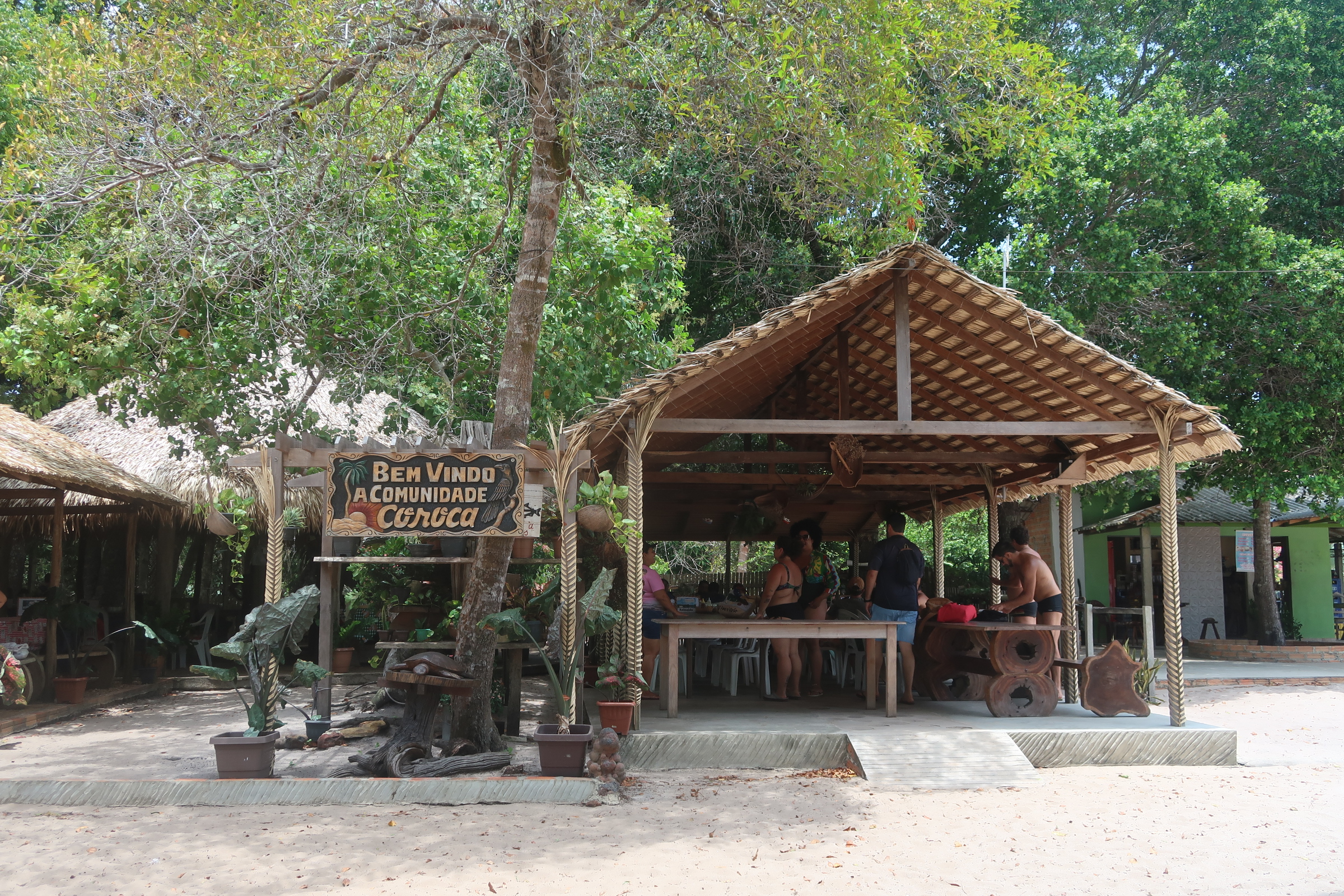
Our guide was Luze, who started the tour by showing us the tucumã palm, used for making crafts. The artisans create beautiful baskets and other items with the palm, using natural dyes. As I mentioned earlier, you can buy products in the village of Alter, but there’s much more variety “at the source”: the store in Coroca sells works made there and in seven other communities.
Next, Luze took us to the meliponary, where some families raise stingless bees, like the Canudo and Jandaíra. Meliponiculture is a sustainable practice that helps preserve these bees, contributing to the conservation of local biodiversity.



Luze explained the differences between Jandaíra honey, which is milder, and Canudo honey, which has more medicinal properties. She also explained how meliponiculture works; for example, I learned that some bees are better for producing propolis, while others are better for honey, and that the color of the honey varies depending on the bloom.
Then we visited the community’s turtle preservation project, where they raise turtles and to later reintroduce them into the river. In the nursery, the animals are protected during the early stages of their lives and are later moved to a pond. In 2023, the community managed to return 1,400 animals to the river. Pretty cool, right?

We visited the nursery and then the pond, which has a floating platform where we could climb up to see the adult turtles. They all come to the surface when the guide throws food; it’s so cute to see them crowding to eat!




After that, we went to the little store, and I wanted to buy absolutely everything! I found the baskets beautiful, and there were also various products made with honey.
I loved that each product made from tucumã palm had the name of the person who made it. Buying crafts directly from the producers ensures that the income goes towards local development without middlemen, so it’s great to spend some money there if you can.


Then it was lunchtime (R$ 60 per person). Once again, we were served delicious fish and generous side dishes. There were also several dessert options made with local fruits (charged separately). Before leaving, we enjoyed the riverside resting area to digest our meal lying on hammocks.

We stayed in the community until around 4 PM and then headed to the beautiful Caracaraí beach. We spent about 30 minutes enjoying the tranquility of the beach, which was delightfully deserted. To close the day, we went to watch the sunset at Ponta do Muretá.
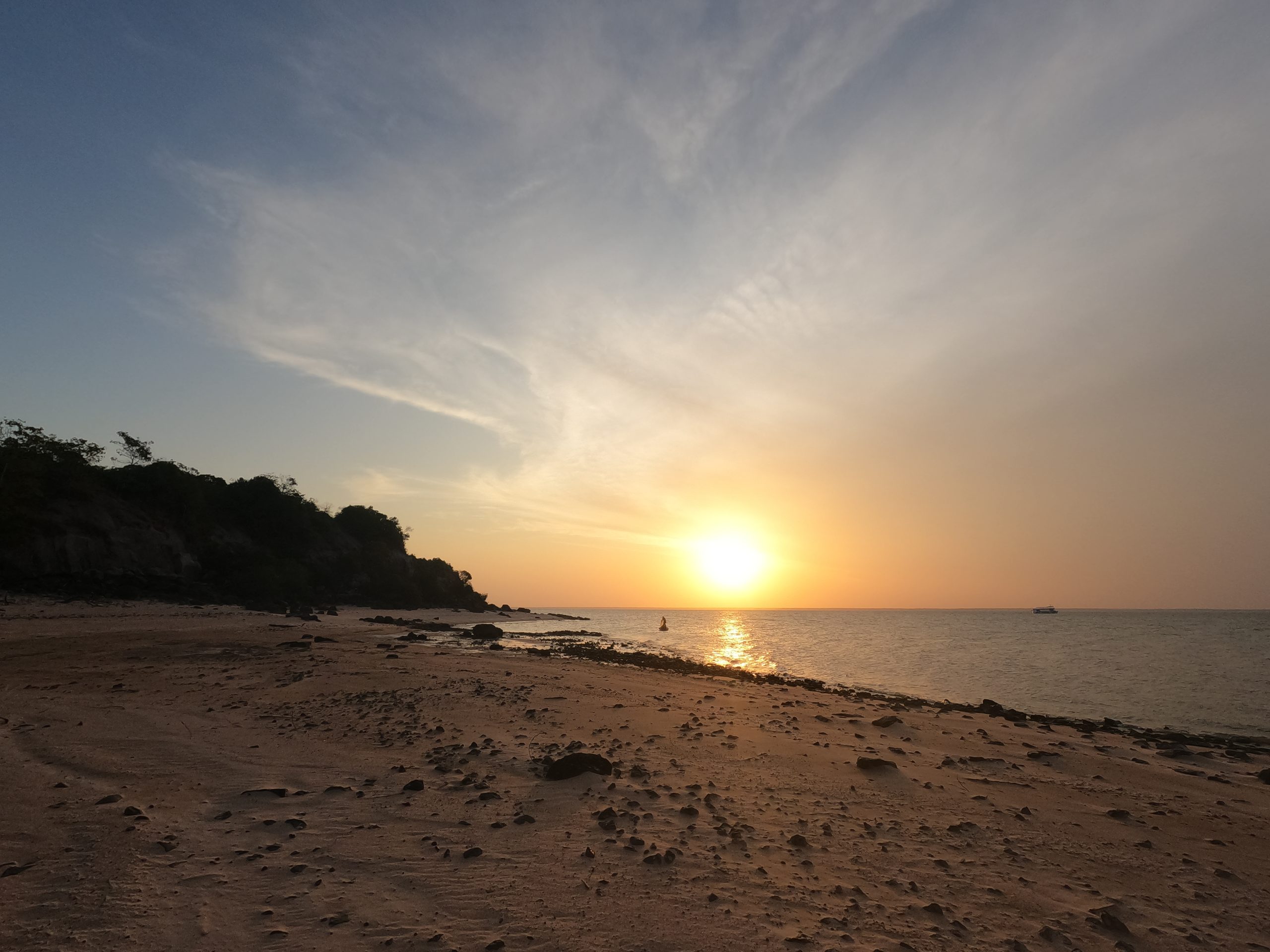
If anyone wants to spend more time in the Rio Arapiuns area, it’s possible to stay in Coroca and other riverside communities that welcome tourists. You can spend the night in hammocks or in local homes.
Tapajós South Circuit (Beaches of Belterra)
On my last day of excursions in Alter do Chão, I hired a boatman along with a friend from Rio who happened to be there and a woman she met at the hostel. In theory, we were going to do the so-called Tapajós South Circuit (Circuito Tapajós Sul), which passes by some beaches in the municipality of Belterra.
The Tapajós South Circuit usually navigates the Tapajós River, stopping at the beaches of Pindobal, Muretá, Jucuruí, and Caxambu. Lunch (charged separately) is usually at Pindobal beach, where there are good restaurants. Other beautiful beaches in this area, according to my research, include Ponta do Cajutuba, Praia de Aramanai, Praia de São Domingos, and Praia do Maguari.
The Mãe Natureza agency charged us R$ 150 per person, considering there would be four of us (but the fourth person who booked with them didn’t show up). In the end, since it was just the three of us and we all wanted to enjoy quieter places without rushing, we ended up creating our own itinerary.
We started the trip heading to Pindobal, where many people spend the whole day because it’s the only one on the route with facilities for food and drinks. The boatman’s plan was to stay there until around 4 PM, but that wasn’t what we were looking for.
The lunch was delicious, and the beach is great for families, since it has bathrooms and even a floating structure for kids. You can also drive there; a driver I quoted charged R$ 180 for a round trip.
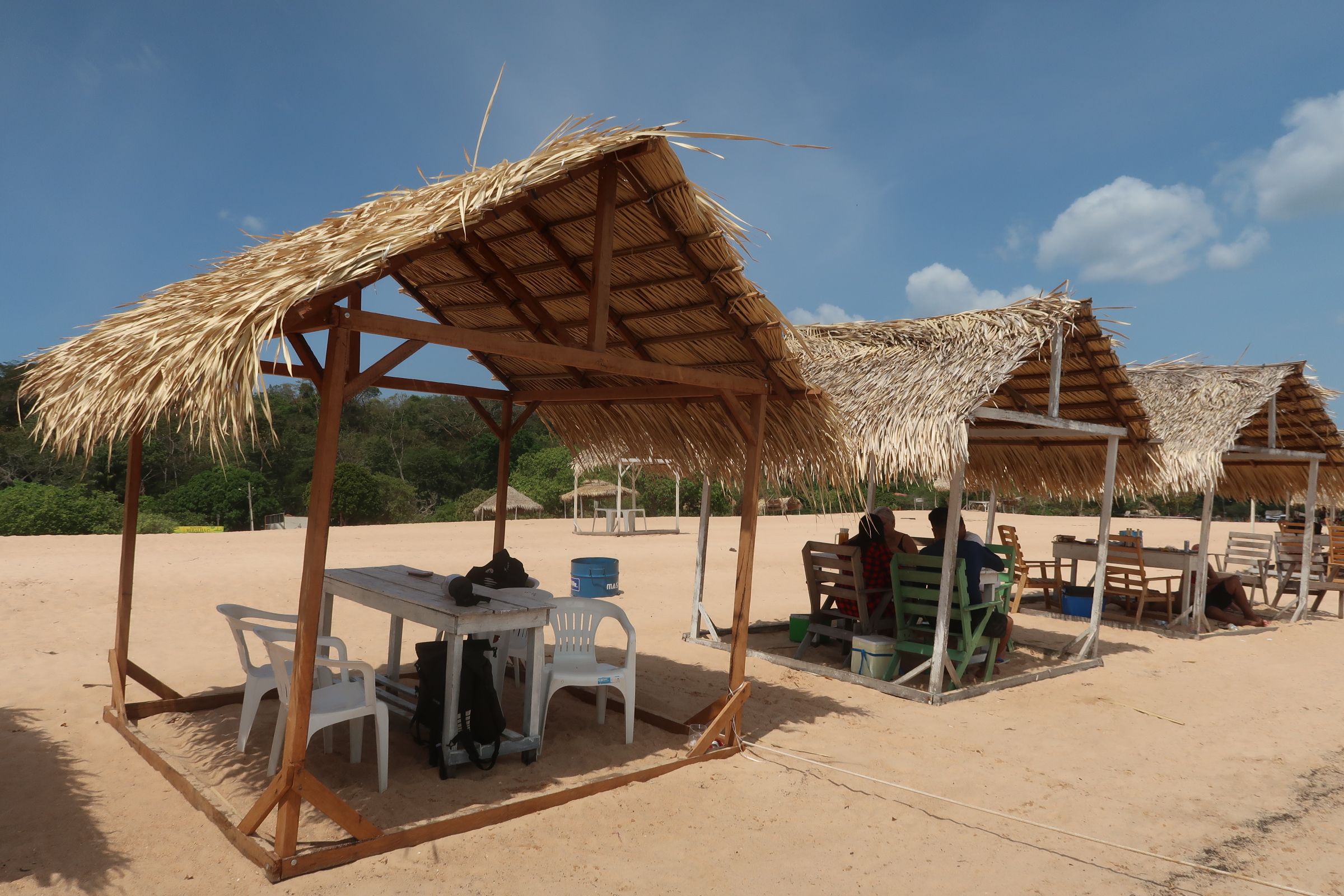

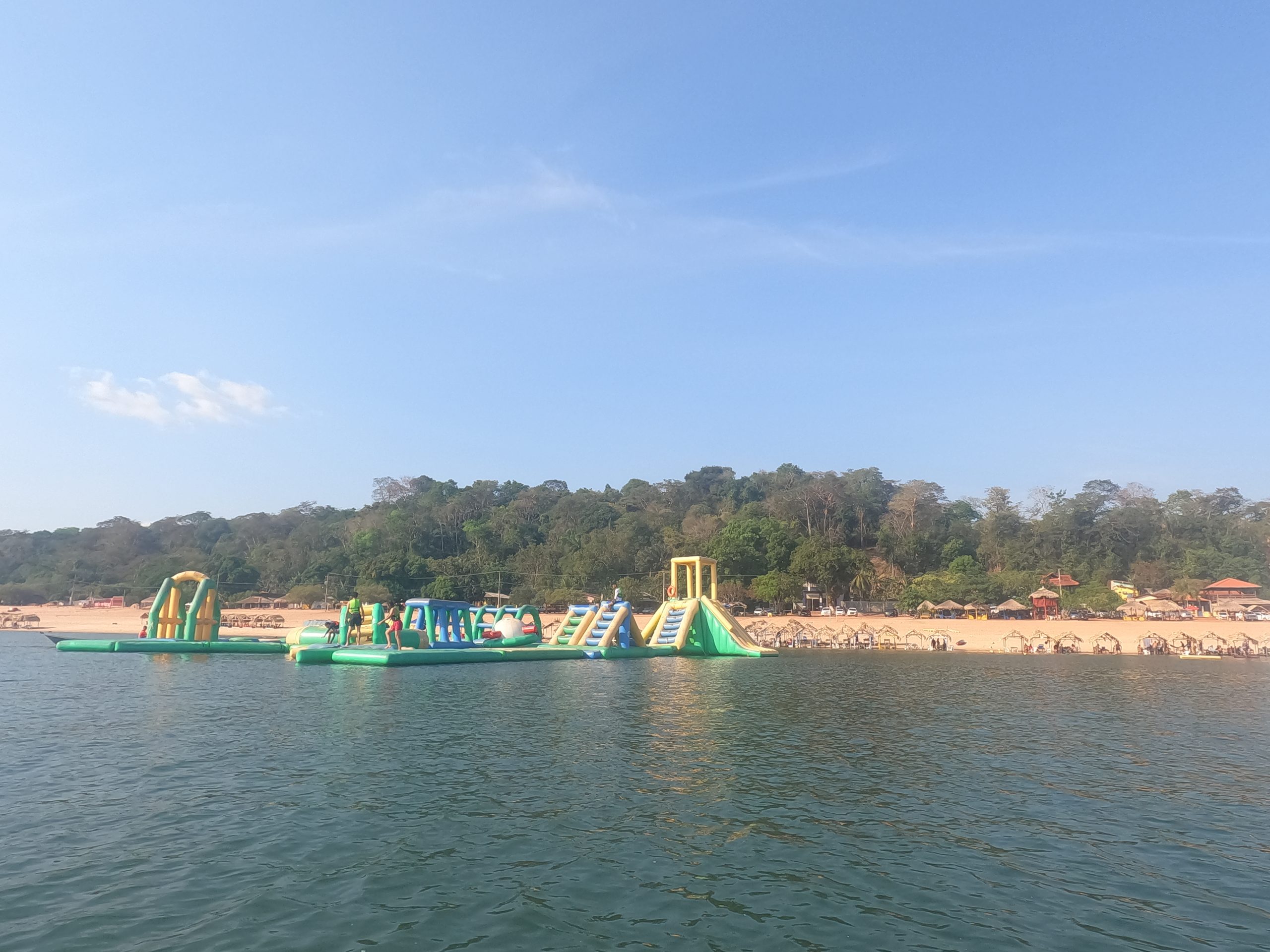
However, Pindobal can get quite crowded, and many people bring portable speakers, and we wanted tranquility. So, we asked the boatman to leave early and take a detour to the Igarapé de Uruçanga, which is just after Pindobal.


The water was refreshing (I love igarapés), and there we met a family from Belterra, with whom we were able to discuss the challenges faced by the local population. Unfortunately, it was clear that the area around the igarapé has been deforested; according to the woman we spoke to, a wealthy man living nearby has committed various environmental crimes and remains unpunished.
From there, we went to Jucuruí beach. There’s a beautiful lagoon there with tree shades for relaxation; one of my companions even fell asleep. After enjoying the lagoon, we returned to the riverbank, which was also lovely. We still had other beaches on the itinerary, but we enjoyed this one so much that we decided to stay and watch the sunset right there.




Other Excursions in Alter do Chão
And the long list of things to do in Alter do Chão doesn’t end there. There are several other beaches to explore, such as Ponta do Jutuba, Praia da Ponta de Pedras, and Praia de Carapanari, all near the village of Alter do Chão. Ponta de Pedras has kiosks and quieter spots, while Carapanari has straw huts and the famous Casa do Saulo restaurant.
If you’re looking to immerse yourself in the forest while admiring the local fauna, it’s worth taking the Canal do Jari tour, where you can spot caimans and many birds. Besides the navigation, the route usually includes the Trilha da Preguiça (Sloth Trail), where you can see these friendly animals, and a visit to the Jardim de Victoria Regia (Water Lillies Garden). There are also stops at the Casa do Saulo restaurant, at Praia Ponta de Pedras, and at Ponta do Cururu or another location to watch the sunset.
I wanted to take this tour, but it’s only possible during the high-water season and at the beginning of the dry season. During my first days in Alter, the canal was still sufficiently full, but it quickly dried up (earlier than usual, as a reflection of the climate crisis) and the tours were paused.
Finally, if you’re seeking a different and truly authentic experience, contact Tuca Tours (@tuca_tours on Instagram) to learn about the overnight trips they organize. You can sleep in the forest, on the beach, or in local homes.

Where to Stay in Alter do Chão
Did you enjoy the tips on what to do in Alter do Chão? I’ll wrap up this article with some practical information for your trip, starting with where to stay. If you want more detailed suggestions, check out my complete guide on the best places to stay in Alter do Chão.
Accommodation prices in Alter do Chão can vary quite a bit depending on the time of year. As you can imagine, during the low season (from February to June), you’ll likely find more affordable rates than during the high season (from July to January).
During the high season, especially on long holiday weekends, it’s advisable to look for accommodation in advance, or you might not find availability at the best value inns. Below, I’ll recommend some well-rated options.
In terms of location, it’s straightforward: the best choice is to stay near the Praça Central (Central Square), where the Church of Nossa Senhora da Saúde is located. This area is home to the main restaurants and shops in Alter do Chão, and the tour boats leave from either there or the Praia do CAT port, which is about a 5-minute walk away.
If you’re looking for an immersion in nature, you can choose accommodation further away from the center, either in the forest or by the river. However, you’ll likely need to call for taxis to get around.
For those seeking experiences more connected to local reality, it’s also possible to take overnight trips in the forest, at secluded beaches, or in riverside communities along the Rio Arapiuns – as I mentioned, Tuca Tours is one of the companies that offers these.
Accommodations in the Center of Alter Village
If you want to know where to stay in Alter do Chão close to the center and the waterfront, check out Hotel Borari, Hotel Mirante da Ilha, Pousada Sombra do Cajueiro, and Pousada do Mingote.
A bit farther from the Central Square, but still in the center of Alter, other options with excellent reputations are Hotel Terra Nativa, Pousada Ocazum, and Villa Éden.
Inns, Hostels, and Other Budget Accommodations
Want to save money? Then consider staying at Hostel Pousada do Tapajós (my friend stayed there and liked it), Caju Hostel, Pousada Pedra do Sol, Pousada Vila Alter or Agualinda Hotel.
Nature-Integrated Accommodations
If you want a nature-integrated experience with plenty of comfort, great options include the stunning Casa da Árvore and Villa Arumã Pousada.
Another great option for where to stay in Alter is Pousada Amazônia. A friend stayed there and loved it. I didn’t see the rooms, but I used the common area, which is open to non-guests, and enjoyed it. There’s a nice pool and a small igarapé on the property. I had delicious juices at the pool bar; I heard the snacks and dishes are good too.
Still haven’t decided on where to stay? Check out all the accommodations in Alter do Chão.


You might also like to read:
Where to stay in São Paulo, Brazil
Best places to stay in Rio de Janeiro
Where to stay in Salvador, Bahia
Other Travel Tips for Alter do Chão, Brazil
How Long to Stay
The ideal length of your stay in Alter do Chão depends on the type of trip you’re planning. To explore the main attractions, such as Ilha do Amor, Lago Verde, and the most famous beaches, four days are enough.
If you want to do some excursions, like hiking through the Tapajós National Forest and visiting riverside communities, and maybe spend a night at the beach or in the forest, stay for a week. Additionally, it’s always worth reserving extra time to relax on the beaches and enjoy nature.
What to Pack
When packing for Alter do Chão, prioritize light and comfortable clothing, such as t-shirts, shorts, and swimwear, since the heat is intense, and the excursions usually involve water activities.
Don’t forget sunglasses and sunscreen. Insect repellent is also important, especially for the hikes. Bring flip-flops or sandals and sneakers if you plan to hike.
It’s good to also bring a small backpack for excursions and a waterproof bag to protect anything that can’t get wet. A raincoat can be useful during the rainy season.
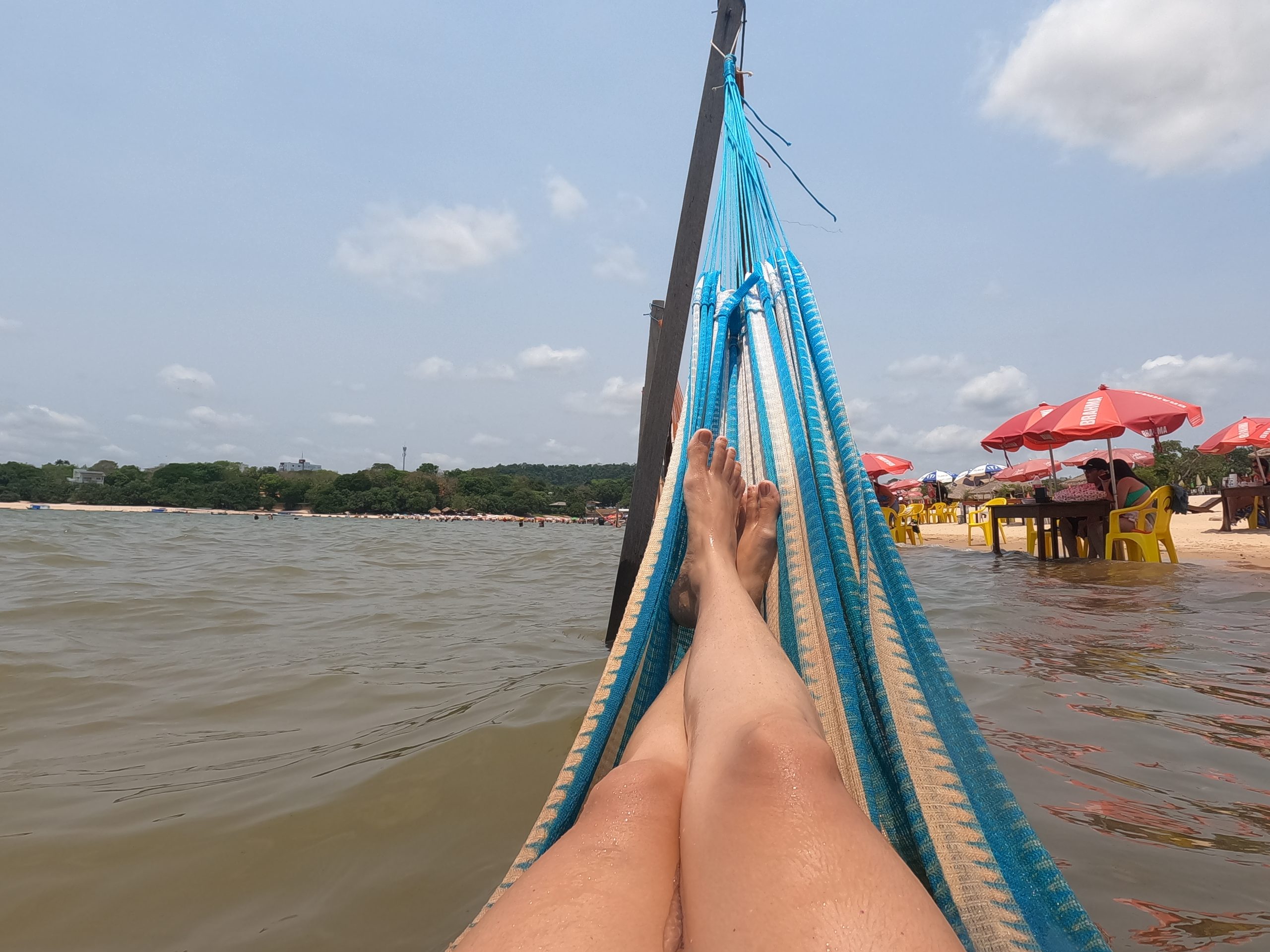





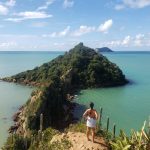














0 Comentários